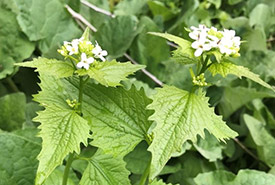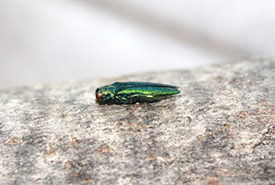NCC: Land Lines – What happens to invasive species in the winter?

Second-year garlic mustard plant (Photo courtesy Invasive Species Centre)
With the change in seasons, invasive species may become out of sight and out of mind. But they always seem to come back every year. So where do they go in winter? Researchers are working to answer this question by investigating how invasive species behave and how they are equipped to survive the winter and re-emerge when warmer temperatures return.
Related content
There are many ways that invasive species adapt to Canada’s seasons. Garlic mustard is biennial, meaning it takes two years to complete its life cycle. In year one, it remains a small plant called a basal rosette, with two or three small leaves and a small root system. It then overwinters with green leaves — very unique! It is then ready to spring into action when the snow melts and kick-start a big year that involves flowering, seeding and rapid aboveground growth.
Some invasive species are particularly adapted to survive the cold winters of northern Canada. Recent research has been done to understand the overwintering behaviour of emerald ash borer (EAB). EAB is a metallic wood-boring beetle that is native to East Asia. All species of North American ash trees are very vulnerable to this beetle, which has killed millions of trees, in both forested and urban areas, in Canada.

Emerald ash borer (Photo courtesy Invasive Species Centre)
In Canada, the most northerly detection of EAB is in Winnipeg, Manitoba, first detected in December 2017. Cold temperatures, like those in Winnipeg, may have minimal impact on the establishment and spread of EAB. Previous research indicated that EAB larvae could not survive below -35.3 C. However, EAB may still be able to survive these cold conditions based on several specific factors and recent research into phenotypic plasticity indicates they could survive temperatures that are much colder. Phenotypic plasticity is the ability of an organism to change its traits in response to the environment without the need for changes at the genetic level. Extreme phenotypic plasticity of cold tolerance allowed the EAB in this new study to adapt to Canadian winters and survive temperatures as low as -50 C! These findings mean that EAB have the potential to survive some of the harshest winters in regions where their host trees grow.
First, EAB larvae overwinter under the bark of ash trees. Windchill does not affect EAB, as the bark provides protection from the wind, cold and weather. The larvae residing near the bottom of a tree and beneath the snowline benefit from the additional insulation and protection from the elements. EAB larvae even synthesize anti-freeze agents internally in the fall to survive winter! The peak of their cold tolerance is mid-winter (January and February). As a result, a cold snap in late fall or early spring (when they are not fully acclimatized) may have a greater impact on EAB survival than sustained cold temperatures mid-winter. There may be some benefits to early winter weather and lingering cold weather.
This story becomes more complicated when we look at the impacts of climate change and the increased variability of weather in Canada. As the severity of winters across the country changes from year to year, more invasive species may be able to survive in Canada, and so the need for greater prevention and control measures of invasive species becomes even more important.
Although invasive species may be in hibernation during the winter, they re-emerge in the spring. In the meantime, small actions on our part can make a big difference. Year round, firewood should be sourced in the same area it will be burned. More targeted actions in the winter can also help stop the spread of invasive species — staying on the trail and cleaning off your boots, gear and dog’s paws to help prevent the spread of invasive plant seeds.
Learn more about invasive species threatening Canada’s natural spaces here.
This blog was originally written in 2019 by Meaghan Luis, business development and communications coordinator with ISC, and reposted with an update in 2022 by Tera Shewchenko, ISC’s science writer intern.





